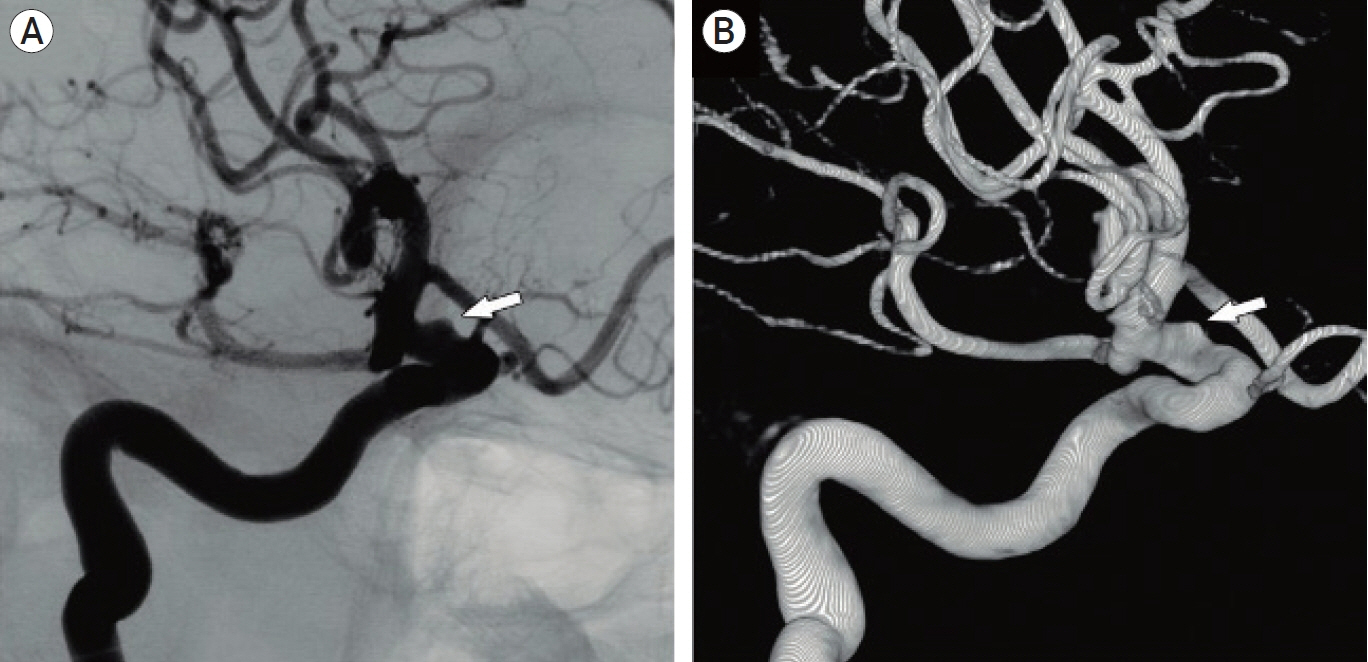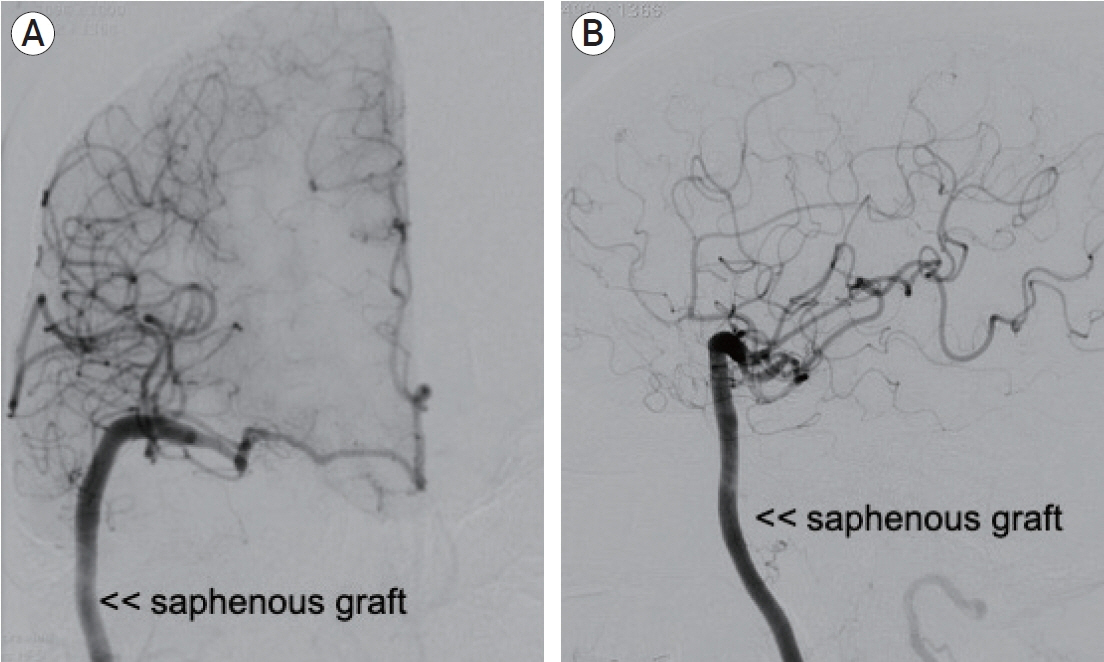J Cerebrovasc Endovasc Neurosurg.
2021 Sep;23(3):245-250. 10.7461/jcen.2021.E2020.12.001.
Slip Clip after successful microsurgery of a blister aneurysm: Should bypass always be the first option?
- Affiliations
-
- 1Division of Neurosurgery, Department of Surgery, Santa Casa de São Paulo School of Medical Sciences. São Paulo (SP), Brazil
- KMID: 2520884
- DOI: http://doi.org/10.7461/jcen.2021.E2020.12.001
Abstract
- Blood Blister-like aneurysms are intracranial non-saccular aneurysms with higher rupture risk due to its fragile wall. Diagnosis is performed in the acute phase of a subarachnoid hemorrhage. There are several treatment options based on reconstructive or deconstructive techniques. This paper aims to discuss the limitations of microsurgery clipping for a ruptured blister aneurysm. We report on a case of a female patient presented with a Fisher III subarachnoid hemorrhage. Cerebral angiography revealed an internal carotid artery blister aneurysm. Initially microsurgery clipping was successfully performed. However, after a few days the patient presented new subarachnoid hemorrhage. The new cerebral angiography showed growth of the previously clipped aneurysm, with displacement of the clip from the position adjacent to the artery. High-flow bypass was performed obtaining definitive treatment. This is a definitive approach for blister aneurysms. If microsurgery clipping is chosen, a strict follow-up is required due to the dynamic nature of this lesion and the chance of re-bleeding even after successfully clipping.
Figure
Reference
-
1. Bojanowski MW, Weil AG, McLaughlin N, Chaalala C, Magro E, Fournier JY. Morphological aspects of blister aneurysms and nuances for surgical treatment. J Neurosurg. 2015; Nov. 123(5):1156–65.
Article2. Coutinho JM, Sacho RH, Schaafsma JD, Agid R, Krings T, Radovanovic I, et al. High-Resolution Vessel Wall Magnetic Resonance Imaging in Angiogram-Negative Non-Perimesencephalic Subarachnoid Hemorrhage. Clin Neuroradiol. 2017; Jun. 27(2):175–83.
Article3. Gonzalez AM, Narata AP, Yilmaz H, Bijlenga P, Radovanovic I, Schaller K, et al. Blood blister-like aneurysms: single center experience and systematic literature review. Eur J Radiol. 2014; Jan. 83(1):197–205.
Article4. Hellstern V, Aguilar-Pérez M, AlMatter M, Bhogal P, Henkes E, Ganslandt O, et al. Microsurgical clipping and endovascular flow diversion of ruptured anterior circulation blood blister-like aneurysms. Interv Neuroradiol. 2018; Dec. 24(6):615–23.
Article5. Indo M, Oya S, Tanaka M, Matsui T. High incidence of ICA anterior wall aneurysms in patients with an anomalous origin of the ophthalmic artery: possible relevance to the pathogenesis of aneurysm formation. J Neurosurg. 2014; Jan. 120(1):93–8.
Article6. Ji T, Guo Y, Huang X, Xu B, Xu K, Yu J. Current status of the treatment of blood blister-like aneurysms of the supraclinoid internal carotid artery: A review. Int J Med Sci. 2017; Apr. 8. 14(4):390–402.
Article7. Lee CC, Hsieh TC, Wang YC, Lo YL, Lee ST, Yang TC. Ruptured symptomatic internal carotid artery dorsal wall aneurysm with rapid configurational change. Clinical experience and management outcome: an original article. Eur J Neurol. 2010; Oct. 17(10):1277–84.
Article8. Mokin M, Chinea A, Primiani CT, Ren Z, Kan P, Srinivasan VM, et al. Treatment of blood blister aneurysms of the internal carotid artery with flow diversion. J Neurointerv Surg. 2018; Nov. 10(11):1074–8.
Article9. Nakatomi H, Segawa H, Kurata A, Shiokawa Y, Nagata K, Kamiyama H, et al. Clinicopathological study of intracranial fusiform and dolichoectatic aneurysms: insight on the mechanism of growth. Stroke. 2000; Apr. 31(4):896–900.10. Park TJ, Kim KH, Cho JH. The blood blister like-aneurysm: usefulness of Sundt Clip. J Cerebrovasc Endovasc Neurosurg. 2017; Sep. 19(3):171–83.
Article11. Peitz GW, Sy CA, Grandhi R. Endovascular treatment of blister aneurysms. Neurosurg Focus. 2017; Jun. 42(6):E12.
Article12. Peschillo S, Missori P, Piano M, Cannizzaro D, Guidetti G, Santoro A, et al. Blister-like aneurysms of middle cerebral artery: a multicenter retrospective review of diagnosis and treatment in three patients. Neurosurg Rev. 2015; Jan. 38(1):197–202. discussion 202-3.
Article13. Shigeta H, Kyoshima K, Nakagawa F, Kobayashi S. Dorsal internal carotid artery aneurysms with special reference to angiographic presentation and surgical management. Acta Neurochir (Wien). 1992; 119(1-4):42–8.
Article14. Sorimachi T, Osada T, Hirayama A, Shigematsu H, Srivatanakul K, Matsumae M. Preservation of anterior choroidal artery blood flow during trapping of the internal carotid artery for a ruptured blood Blister-like aneurysm with highflow bypass. World Neurosurg. 2019; Feb. 122:e847–55.
Article15. Strickland BA, Rennert RC, Bakhsheshian J, Ravina K, Fredrickson V, Giannotta SL, et al. Extracranial-intracranial bypass for treatment of Blister aneurysms: efficacy and analysis of complications compared with alternative treatment strategies. World Neurosurg. 2018; Sep. 117:e417–24.
Article16. Wang L, Cai L, Qian H, Shi X. Overestimated role of extra-cranial-to-intracranial bypass in management of Blood-Blister aneurysm. World Neurosurg. 2018; Oct. 118:391–2.
Article17. Xu D, Xie X, You C. Angiographic appearance of Pulsatile Blister aneurysm. World Neurosurg. 2018; Feb. 110:371–2.
Article18. Zeineddine HA, Jones W, Conner CR, Simpson B, Blackburn S, Day AL. Spontaneous healing of a ruptured Blood Blister-like aneurysm. World Neurosurg. 2018; Nov. 119:85–8.
Article19. Zhao Y, Zhang Q, Wang S, Zhang D, Zhang Y, Zhao Y. Comparison of radiological and clinical characteristics between blood blister-like aneurysms (BBAs) and non-blister aneurysms at the supraclinoid segment of internal carotid artery. Neurosurg Rev. 2019; Jun. 42(2):549–57.
Article20. Zhu D, Yan Y, Zhao P, Duan G, Zhao R, Liu J, et al. Safety and efficacy of flow diverter treatment for Blood Blister-like aneurysm: a systematic review and meta-analysis. World Neurosurg. 2018; Oct. 118:e79–86.
Article
- Full Text Links
- Actions
-
Cited
- CITED
-
- Close
- Share
- Similar articles
-
- Clip Compression Injury of the Oculomotor Nerve: Its Prevention and Recovery
- The Sundt Encircling Clip as a Vascular Rescue: A Case Report and a Review of Repair Methods for Arterial Tearing
- True Posterior Communicating Artery Aneurysm
- Ideal Internal Carotid Artery Trapping Technique without Bypass in a Patient with Insufficient Collateral Flow
- Long-Term Clinical and Angiographic Outcomes of Wrap-Clipping Strategies for Unclippable Cerebral Aneurysms





